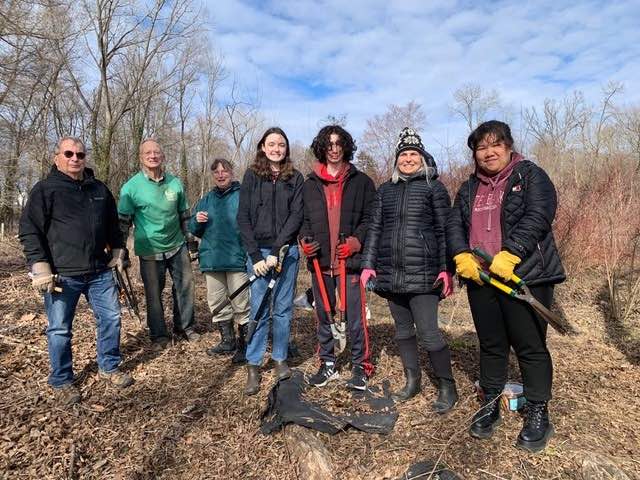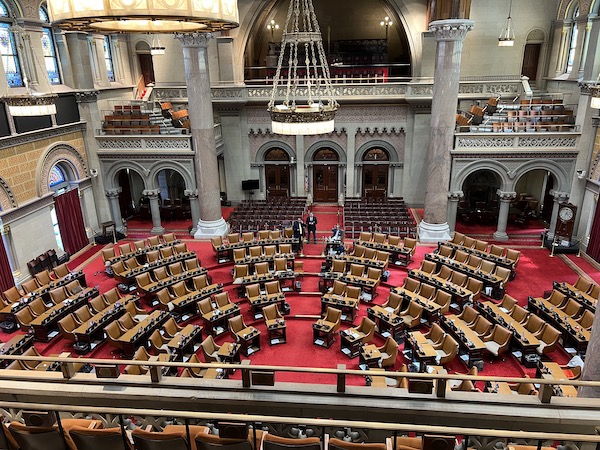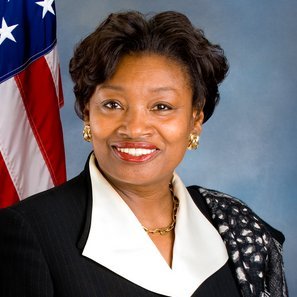Stop the English Ivy Invasion
- Details
- Written by: Joanne Wallenstein
- Hits: 2211
 This article was submitted by Madelaine Eppenstein President of the Friends of Scarsdale Parks
This article was submitted by Madelaine Eppenstein President of the Friends of Scarsdale Parks
English ivy, an aggressively invasive, non-native evergreen vine, is literally engulfing and destroying Scarsdale’s majestic shade trees and evergreen conifers. While some consider an evergreen cover on tree trunks to be attractive, allowing vines to grow on trees is dangerous and potentially fatal to even the largest mature tree. English ivy is considered an “invasive species” in New York State, defined as “non-native to the ecosystem under consideration. . . whose introduction causes or is likely to cause economic or environmental harm or harm to human health.” Ivy blocks sunlight from reaching a tree’s own leaves, which weakens the tree by impeding photosynthesis. Ivy usurps nutrients and water from soil, depleting a tree’s resources. Adding significant weight to tree branches, ivy makes them more susceptible to damage from high winds, heavy ice, and snow.
We urge Scarsdale’s homeowners, landscapers, and government to take action to protect village trees from English ivy vine damage. Besides the enormous cost of removing dead or dying trees, losing trees means losing the significant environmental services that trees provide to filter air by capturing carbon and releasing oxygen, slow and absorb runoff and flooding, cool homes in summer, and provide food and shelter for songbirds and other wildlife.
To save our trees residents can help remove destructive ivy and other invasive vines and prevent further injury. This is the technique favored by Friends of Scarsdale Parks, Inc. (FOSP), the environmental nonprofit active in Scarsdale since 1957, and practiced by other local groups including the Bronx River Parkway Reservation Conservancy.
Using pruners, loppers, and hand saws to cut the vines, remove and discard a section approximately 12-24 inches long on the lower part of the trunk, taking care not to damage the tree’s bark. Do not pull the remaining ivy off the trunk, as this may damage the tree or cause upper tree branches to fall. While some experts have recommended painting the cut ends of ivy with pesticide, this should be done only by professionals and avoided due to the health and safety dangers of pesticides as acknowledged in the recently codified Village policy banning most uses of pesticides on public property.
Before tackling the ivy, make sure you can distinguish English ivy and avoid contact with poison ivy. Wear long sleeves, pants, socks, and gloves to protect yourself from poison ivy and ticks. Or instruct your landscaper to emancipate your trees now as part of spring clean-up, or any time after the tree leaves have fallen in fall or winter.
 Vine cutting session at the Harwood Park wetland restoration site along Brewster Road, attended by FOSP board members and student liaison, Scarsdale HS Garden Club members, and two former Scarsdale mayors. Photos by Cynthia Roberts.
Vine cutting session at the Harwood Park wetland restoration site along Brewster Road, attended by FOSP board members and student liaison, Scarsdale HS Garden Club members, and two former Scarsdale mayors. Photos by Cynthia Roberts.
We invite the community to participate in the effort to save Scarsdale’s trees beginning with the trees on your own residential properties. Please contact us at meppenstein@eppenstein.com or 914-262-6656 if you have any questions, or would like to join in an organized community effort to save our trees from harmful vines. Learn more about English ivy and other invasive species, and find useful how-to information here and here. Join Pollinator Pathway by removing invasives, planting natives, and avoiding pesticides at https://www.pollinator-pathway.org/.
Madelaine Eppenstein, FOSP President
Cynthia Roberts, FOSP Vice President
Dr. Darlene LeFrancois Haber, Scarsdale Forum Inc. Sustainability Committee Chair
Hochul's Housing Plan Shelved
- Details
- Written by: Joanne Wallenstein
- Hits: 8126
 Governor Kathy Hochul’s much feared housing compact has been abandoned. The plan, which was a part of the NYS budget, was a major thorn in the budget negotiations and fell apart due to opposition from many quarters.
Governor Kathy Hochul’s much feared housing compact has been abandoned. The plan, which was a part of the NYS budget, was a major thorn in the budget negotiations and fell apart due to opposition from many quarters.
In Scarsdale and other suburban locations along the Metro North and Long Island Railroad lines, the plan would have cleared the way for large scale development within a half mile of the train stations by allowing builders to override local zoning code. Protections for the environment, stormwater, parking, and density would have been ignored to facilitate multifamily housing on what is now zoned as single home lots.
But it turns out that suburban legislators were not the only ones objecting to the plan.
According to reports, advocates for tenants were vying for protection from eviction and the plan failed to address their pleas. They were seeking a provision called “good cause eviction,” protection which would require landlords to show good cause before evicting tenants as well as limitations on rent increases, similar to rent control. Another proposed program would have provided rental assistance vouchers for homeless New Yorkers and tenants at risk of eviction.
The building unions were also opposed to the plan as it did not include fair wage and labor standards into the housing expansion.
Legislators from more densely populated portions of Manhattan, Brooklyn and Queens also opposed the provision in the bill that would have lifted the floor area ratio (FAR) requirement that requires residential buildings to be up to 12 times the size of their lot in what’s known as the density cap. This would have allowed developers to vastly increase the size of their projects and further crowd already packed areas.
Here are some comments from local leaders on the news.
Susan Douglass, President of the Scarsdale Forum who wrote a detailed position paper on the possible effects of the legislation on Scarsdale said, “ Governor Hochul has "shelved" the Housing Compact for now, in a strategy to get the already delayed State budget passed. According to published information from news sources, State Assembly and Senate leaders have been unwilling in budget negotiations to support part of Governor Hochul’s plan that would allow the State to override local zoning laws for new housing developments.
However, Governor Hochul and state lawmakers could still negotiate a housing deal in the legislative session, outside of the budget process. Therefore, it is incumbent upon Scarsdale to closely follow the process and be prepared to study and weigh in on any new proposals. Moreover, it may be prudent for Scarsdale officials, civic organizations such as the Scarsdale Forum and others, along with concerned citizens, to study and perhaps propose options to create new housing in Scarsdale, a portion of which might be affordable. This would put us in a position of being proactive rather than reactive.
State Assemblymember Amy Paulin who represents Scarsdale in Albany and fought against the compact said, “Thankfully, the Governor’s housing compact proposal was struck. I respect the Governor’s commitment and agree with her goal to increase housing in New York State. It is something we need. That being said I felt her proposal was untenable for our area, and for many areas throughout the state which could not withstand the proposed density and pace of housing development.”
State Senator Shelley Mayer said, "It is clear to me for some time that Westchester needs - and must have - more affordable housing if it is to continue to be a diverse, thriving county that supports a path to the middle class. That being said, I made it abundantly clear to my colleagues and our Senate Leader that the Governor's proposed Housing Compact, with its 3% growth target, transit-oriented development requirements, and overriding of local zoning, was the wrong approach to the issues we face. I felt strongly it was a top-down, one size fits all approach that failed to incorporate the views of local elected officials and homeowners and failed to acknowledge that many suburban communities in Westchester have been and stand ready to find ways to provide affordable housing in their communities. I spoke out and am pleased that the Governor ultimately withdrew her plans. I look forward to working with my legislative colleagues, Governor Hochul and our county and local leaders, to find constructive ways to increase the supply of affordable housing in Westchester."
And Melanie Spivak, who is on the Board of the Scarsdale’s Neighborhood Associations and rallied residents to write letters opposing the housing compact said, “Although there is a definite need for more housing, especially affordable housing, Governor Hochul’s proposal was an unrealistic solution. As always, one size solutions don’t fit all size communities. Increased housing density must be built in areas where the infrastructure can handle it, where municipalities can assure it can be built in the proper place, in a safe and environmentally proper location, without a time clock, and in a way that enhances the uniqueness of each community. Local control of our zoning laws and building requirements are imperative to protecting our unique village. I am grateful for the hard work and perseverance of Amy Paulin, who understands our community and represented Scarsdale in helping to defeat the Governor’s short- sighted housing proposal. I look forward to building housing in our community that enhances its qualities, not hurt it.”
SNAP Presidents Urge You to Write to the Governor About Housing Legislation Now!
- Details
- Written by: Joanne Wallenstein
- Hits: 2711
 Scarsdale’s Neighborhood Presidents are alerting residents to proposed legislation that would challenge Scarsdale’s zoning code and permit mass development within a half mile of the Metro North train stations in Scarsdale and Hartsdale.
Scarsdale’s Neighborhood Presidents are alerting residents to proposed legislation that would challenge Scarsdale’s zoning code and permit mass development within a half mile of the Metro North train stations in Scarsdale and Hartsdale.
Below find an email from Melanie Spivak and signed by all of Scarsdale’s Neighborhood Association Presidents, urging you to send letters to Governor Kathy Hochul and State Senator Andrea Stewart Cousins this weekend:
(From Ms. Spivak)
It is urgent that you educate yourselves on what is going on in Albany these last few weeks. Governor Hochul has included a bill in her budget called "The New Homes Target Act". This is a bill that will have a tremendous effect on every individual in Westchester, Orange, Putnam, Dutchess, Rockland and Nassau counties. It will affect every one of us in Scarsdale.
The budget is currently stalled in Albany in negotiations with the Governor and is currently scheduled for a vote this Monday April 17.
Please read the following statement, created and endorsed by SNAP (Scarsdale Neighborhood Association Presidents), which gives a very quick overview of some of the alarming requirements in the bill.
At the request of our representative in Albany Amy Paulin, she has asked everyone to reach out to Senator Andrea Stuart-Cousins and Governor Hochul directly to make your voices heard. We have included a sample letter to help talking points for a phone call, email or letter, along with the contact information for each representative.
Please take the time to read the statement and contact the Governor and Senator. But, please act fast!
I am happy to answer any questions or share the bill with you.
Thank you for your immediate attention.
Melanie Spivak
URGENT
SNAP Statement on Governor Hochul’s New Homes Target Act 4/13/23 Governor Kathy Hochul
Governor Kathy Hochul
Governor Hochul has proposed a new law that would require Scarsdale to add approximately 180 new housing units to Scarsdale over the next three years. The New Homes Act has the potential to permanently change suburban New York. The Act is currently advancing through the budget process and is scheduled for a vote on April 17 - in 4 days.
Scarsdale homeowners must be aware that the Act would *require* the following:
First: A 3% increase in housing stock every three years - which amounts to approximately 180 new units in Scarsdale in the first three-year cycle and a greater number in each cycle thereafter; a percentage of these units must be low-income housing as defined in the Act.
Second: High-density housing (eg multi-family homes and apartment buildings). In its current form, the Act requires housing be located within a half-mile radius of a transportation hub. This provision is still being negotiated and could be changed to permit building anywhere within a town, village, or city; with no recourse for a municipalities’ inability to comply.
Third: A severe penalty for failure to comply. If a municipality fails to produce the required number of new housing units per year, the Governor will remove “home rule” (an individual municipality’s right to determine zoning), a right afforded to municipalities in our New York State Constitution.
What does this mean for Scarsdale and what does it mean for you?
• Infrastructure: Our 100+ year old infrastructure - which is already beyond its lifespan - would be stretched even further beyond its capacity.
• Flooding: The addition of high-density housing would further exacerbate Scarsdale’s poor drainage, causing additional flooding.
• Building Limits: The Scarsdale Board of Architectural Review and Engineering department will have to require further building limitations to account for the environmental impact of the increased housing density.
• Schools: Our schools could face an influx of students which might require redistricting of all the elementary schools.
• Loss of local control: Scarsdale has the potential to lose local control of our town.
Governor Hochul’s New Homes Act will totally overwhelm Scarsdale's century-old infrastructure and especially strain our water, sewer and school systems as well as police and fire service, road maintenance and Village center parking and amenities. As a result, the New Homes Act has the potential to lower the value of our homes and take away the unique qualities of small towns.
 State Senator Andrea Stewart-CousinsSNAP is urging all the residents to learn more about the potential impact Governor Hochul’s New Homes Act could have on our community. The time to speak up is now - the budget vote is April 17.
State Senator Andrea Stewart-CousinsSNAP is urging all the residents to learn more about the potential impact Governor Hochul’s New Homes Act could have on our community. The time to speak up is now - the budget vote is April 17.
Please call, send an email or letter to Governor Hochul and Senator Andrea Stuart-Cousins (see attached) and tell them this is the wrong approach because one size does not fit all. If high density housing is needed, it must be thoughtfully planned and include objective review and recourse which takes environmental, infrastructure and capacity of local services into consideration. Forcing the same high density housing requirements onto small towns and villages is not the answer.
Here's a sample letter that you can complete and email to state leaders:
Sample Letter
The Honorable Kathy Hochul
Governor of the State of New York
New York State Capitol Building
Albany, New York 12224
Phone: (518) 474-8390
Email (fill out the form located here): www.Governor.ny.gov
Senator Andrea Stewart-Cousins
28 Wells Avenue, Building #3, 5th Floor Yonkers, NY 10701
Phone: (914) 423-4031
Email: scousins@nysenate.gov
Speaker Carl Heastie
Dear (Governor Hochul) (Senator Stewart-Cousins):
My name is ____________________.
I am a New York resident and I OPPOSE the New Homes Target Act proposed in the 2023 Budget.
The Act forces high density housing onto municipalities that are not equipped to handle a sudden large influx of building and residents - with no recourse for damage to our infrastructure or environment. The requirements of the Act are short-sighted. Your proposal usurps our constitutional right of “home rule” (zoning autonomy). The building requirements promulgated by this Act are unacceptable and will have the chilling effect of eliminating the suburban landscape of our state.
High density housing should be built in areas that can handle the additional stress on local infrastructure and the environment.
Municipalities must have the ability to provide all residents with a sustainable quality of life free from unnecessary flooding, sewage and overcrowding.
One size does not fit all; high density housing is not appropriate for all communities. New York residents must be able to retain local control of their homes and communities.
This proposal should not be allowed to move forward.
Sincerely,
Your Name:
Your Address:
Your Email:
Westchester Officials Respond to Hochul's Housing Proposal
- Details
- Written by: Joanne Wallenstein
- Hits: 7646
 In her proposed 2023-24 budget, Governor Kathy Hochul is proposing ambitious goals for housing development in communities like Scarsdale that are served by Metro North. Her plan calls for communities like Scarsdale to increase the number of housing units by 3% in the first three years and another 3% in the next three years.
In her proposed 2023-24 budget, Governor Kathy Hochul is proposing ambitious goals for housing development in communities like Scarsdale that are served by Metro North. Her plan calls for communities like Scarsdale to increase the number of housing units by 3% in the first three years and another 3% in the next three years.
It also mandates zoning changes which allow for multi family housing within a half mile of train stations, of more than 50 units per acre and would override local zoning code and environmental regulations.
A group of officials representing Westchester, called the Westchester Municiapl Officials Association subcommittee on housing, sent the following letter to Hochul in late February.
We asked Village Manager Rob Cole why no one from Scarsdale signed it and he said, “WMOA circulated the letter with a very short turnaround deadline; we could not sign without having had opportunity to review the content.”
Here is the letter:
February 28, 2023
The Honorable Kathy Hochul Governor of New York State NYS State Capitol Building Albany, New York 12224
Re: New York Housing Compact
Dear Governor Hochul,
The WMOA subcommittee on housing believes that new housing in this region is critically important for the health of our communities. Suburban attitudes about housing development are not the same as they once were. In fact, many Westchester communities are already exceeding your housing targets and many others are working diligently to do so.
We support your desire to make progress on this issue. Unfortunately, we cannot support the Housing Compact in its current form. Without significant changes, it simply will not work.
The suburbs are not monolithic, nor are we merely satellites for New York City. Each of our municipalities has different housing needs and different obstacles to overcome, and no plan will be successful without taking into account the relevant local context. We have shared this context with our state representatives, select members of your team, and the NYS Division of Housing and Community Renewal. We now share highlights of our concerns directly with you, in the hope that you will consider these changes and ensure that the path ahead will be productive.
Transit-Oriented Development (TOD)
The TOD zoning mandate included in the Housing Compact must be removed. Using conservative estimates, the mandated level of density would require us to permit development that would, in many cases, double, triple, and even quadruple the total number of housing units in some of our municipalities. This level of change would require a fundamental re- examination and overhaul of our delivery of public services (schools, traffic, transportation, fire, police, sewers, etc.). Given that the TOD requirements would be exempted from the State Environmental Quality Review process and availed to future developers “as-of-right,” we would lose our ability to properly assess potential impact and make the changes necessary to accommodate such a transformation. This would be devastating to the communities we are sworn to serve, and no elected official, in good conscience, can support such an unreasonable approach to community growth.
As an alternative, we recommend adding TOD type zoning as a Preferred Action to achieve Safe Harbor as one of several options related to the growth targets. Many communities have already zoned for TOD with the goal of increasing the opportunity for housing and mixed-use density near train stations and would be receptive to this approach.
As a preferred action, TOD should be more flexible so municipalities could opt to include areas in their “TOD” plan where there is reasonable access to transit as opposed to inside a prescribed 1⁄2 mile radius. It should also measure density on a project-by-project basis, instead of measuring overall density across large swaths of land that would likely encompass areas where lower density housing is more appropriate.
Nuanced Housing Targets
A 3% housing target may not be appropriate for all communities and targets may need to be higher or lower depending on the realities of specific communities. The growth percentage needs to be calibrated to take into account other factors such as:
• Current housing/population density
• Current number of subsidized and income restricted units
• Current cost of housing compared to County average
• Existing local ADU zoning and the number of units built
• Lack of infrastructure affecting a three-year target completion
• Available land for new construction
• NYC East of Hudson Watershed properties and the MS4 General Permit requirements.
Safe Harbor Based on Preferred Actions
Preferred Actions for Safe Harbor should reward rezoning that encourages the development of additional housing and in particular affordable housing. Municipalities should be able to choose from a broad menu to craft a plan that works for each of them. In the end, a municipality should simply be required to demonstrate the ability to increase its housing stock to the target level based on zoning changes. Municipalities should be able to select from a range of potential zoning modification options, including the following:
• Accessory Dwelling Units
• Housing Lot Splits
• Smart Growth Principles
• Adaptive Reuse (this should also be broadened and include conversion of other types of properties, including summer residences to year round affordable homes)
• Transit-Oriented Development
• Affordable Housing Set Asides of More than 10%
• Comprehensive Plans that Include Smart Growth Strategies
Retain SEQRA
SEQRA requirements should be retained but reformed to include streamlined requirements specific to housing development. When SEQRA is working well, it provides important protections and is needed to promote and accomplish the State’s agenda for addressing the climate crisis. SEQRA reviews are also used as a tool to require developers to pay “fair share” contributions for mitigating the impact of their projects on municipal infrastructure. When it’s not working well, though, it can be used to prevent new developments or slow them down, increasing cost of construction (and the rents needed to offset those costs).
While we agree that the environmental review process could benefit from reform, allowing development to happen without requiring a SEQRA review at all would negatively impact our municipalities, many of which have already been severely affected by flooding caused
by unprecedented massive storms. Abandoning SEQRA altogether for housing will also call into question why non-housing related projects need to abide by the process, while stripping municipal leaders of their ability to make good planning decisions.
For the 19 municipalities in the NYC East of Hudson Watershed it is important to note that NYS has ceded legal control to NYC giving them the ability to protect the NYC and lower Westchester County drinking water. It is doubtful this control can be altered without NYC approval. The MS4 General Permit covers a list of environmental requirements pursuant to Article 17 and Article 70 of the Environmental Conservation law which municipalities in the East of Hudson Watershed must comply with.
As-of-Right / Fast Track Approvals Challenges
Requiring that all zoning changes be “as-of-right” development is likely to lead to unfortunate unintended consequences and should be removed from the proposal. We would caution against emboldening developers to cut corners, evade important environmental and social concerns, and ignore local residents and community groups who can suggest important improvements to project proposals. We believe a fast-track approval process that circumvents local authority will create perverse incentives for developers and will deprive municipalities of valuable leverage needed in negotiations.
Timelines
The timeline for implementation is too tight. Each of us has experience with developers who choose to abandon projects due to personal, economic or market conditions unrelated to municipal constraints. In each of these cases the project must start afresh, and the time invested is lost. Municipalities should not be penalized if developers do not follow through on their plans. It is also doubtful the MS4 SPDES General Permit for Stormwater Discharges for Construction Activity GP 0-20-001 would fall under this timeline.
Incentivize the Desired Housing Stock
More incentives should be devised to create what we believe is the desired housing stock.
Affordable and senior/supportive housing units should count as 3 units and TOD units should count as 1.5 units. Added flexibility could be granted to municipalities who base their plans on a needs assessment, since some communities may already have an abundance of affordable housing but lack higher-end housing that could benefit their tax base.
We also believe that, in keeping with the goals of the Climate Leadership and Community Protection Act (CLCPA) and Environmental Bond Act, incentives should be created for the construction of sustainably-built projects (Net Zero Energy, LEED, Energy Star Certified, etc.)
Expand Financial Support for Infrastructure
More financial support is needed. In our view, $250 million is a fraction of the amount
required to create the infrastructure this level of housing development necessitates. The current engineering estimate for some municipalities is between $70,000 and $100,000 per residential sewer hookup. If only 10% of the 800,000 residences built need new sewer infrastructure or improvements to existing sewer systems that cost is approximately $5.6B to $8B. Engineering estimates of the current cost to replace one mile of storm drain is $1 million and, in a recent bid proposal in southern Westchester, the cost of digging along a state highway to install a sewer line was $600 to $800 per foot.
Expanding water and sewer systems, adding parking structures, evaluating and modifying traffic patterns, and adding bike lanes are just a few of the very expensive projects associated with the increase in housing.
In summary, we recommend that each municipality be required to reach a specific target based on a formula that takes into account existing population density and local housing stock and any other overriding considerations (e.g. NY Watershed). The focus should be incentive-based, and municipalities should be rewarded for demonstrating that they are encouraging appropriate and needed development through a broad range of actions. The Safe Harbor provisions should be expanded to recognize these actions.
Legislation like this is best when created in an open, collaborative manner without artificial time constraints. Given the complexity of this challenge, any proposal of this magnitude should be debated and adopted separate from the budget process.
Though we want to support the Housing Compact, we will not be able to do so unless these vital changes are incorporated.
Thank you for your consideration and time.
Regards,
Westchester Municipal Officials Association – Housing Subcommittee
Nicola Armacost, Mayor, Village of Hastings-on-Hudson
Ellen Calves, Supervisor, Town of Bedford
Theresa Knickerbocker, Mayor, Village of Buchanan
Warren Lucas, Supervisor, Town of North Salem
Chance Mullen, Mayor, Village of Pelham
Gina Picinich, Mayor, Village/Town of Mount Kisco
Peter Scherer, Mayor, Village of Pleasantville
Anne Janiak, Executive Director, Westchester Municipal Officials Association
With support from the following Westchester Mayors and Supervisors:
Omayra Andino
Mayor, Village of Tuckahoe
Richard Becker
Supervisor, Town of Cortlandt
Karen Brown
Mayor, Village of Tarrytown
Tom Diana
Supervisor, Town of Yorktown
Richard Dionisio
Supervisor/Mayor, Town/Village of Harrison
Jaine Elkind Eney
Supervisor, Town of Mamaroneck
Paul Feiner
Supervisor, Town of Greenburgh
Elizabeth Feldman
Supervisor, Town of Ossining
Carl Fulgenzi
Supervisor,
Town of Mount Pleasant
Tony Goncalves
Supervisor, Town of Lewisboro
Kevin Hansan
Supervisor,
Town of Pound Ridge
Nancy Kaboolian
Mayor, Village of Ardsley
Lisa Katz
Supervisor,
Town of New Castle
Jason Klein
Mayor, Village of Rye Brook
Vivian McKenzie
Mayor, City of Peekskill
Dan McLaughlin
Supervisor, Town of Pelham
Tom Murphy
Mayor, Village of Mamaroneck
Vincent Rossillo
Mayor, Village of Dobbs Ferry
Michael Schiliro
Supervisor,
Town of North Castle
Robert Scorrano
Supervisor, Town of Somers
Brian Smith
Mayor, Village of Irvington
Steven Vescio
Mayor,
Village of Briarcliff Manor
Robert Williams
Mayor, Village of Elmsford
Ken Wray
Mayor,
Village of Sleepy Hollow
Gary Zuckerman
Supervisor, Town of Rye
Hon. Andrea Stewart-Cousins, Senate Majority Leader, 35th District
Hon. Carl Heastie, Speaker, NYS Assembly
Hon. Nathalia Fernandez, NYS Senate, 34th District Hon. Jamaal Bailey, NYS Senate, 36th District
Hon. Shelley Mayer, NYS Senate, 37th District
Hon. Peter Harckham, NYS Senate, 40th District Hon. Amy Paulin, NYS Assembly, District 88
Hon. Gary Pretlow, NYS Assembly, District 89
Hon. Nader Sayegh, NYS Assembly, District 90 Hon. Steve Otis, NYS Assembly, District 91
Hon. MaryJane Shimsky, NYS Assembly, District 92 Hon. Chris Burdick, NYS Assembly, District 93 Hon. Matt Slater, NYS Assembly, District 94
Hon. Dana Levenberg, NYS Assembly, District 95
Identities Announced of Five Youths Killed on the Hutch
- Details
- Written by: Joanne Wallenstein
- Hits: 3049
 (Updated March 21) The Westchester County Police are reporting that five young people from Connecticut were killed in a single car accident on the Hutchinson River Parkway at 12:20 am Sunday March 19.
(Updated March 21) The Westchester County Police are reporting that five young people from Connecticut were killed in a single car accident on the Hutchinson River Parkway at 12:20 am Sunday March 19.
According to police there were six people, ranging in age from 8 to 17 years old, going north in a Nissan Rogue that was driven by a 16 year-old boy. The crashed occurred when the driver failed to turn with the roadway, hit a boulder then a tree and caught fire, just north of the Mamaroneck Road exit.
Four males and one female died at the scene. A sixth person, who was sitting in the rear hatchback or cargo section of the car, escaped out the back. The nine year-old boy was taken to Westchester Medical Center in Valhalla with non-life threatening injuries. On MOnday March 20, the victims were identified as follows:
The five persons who were killed in the crash were siblings and cousin, all from Derby, Connecticut. They were returning there from a mall. They were identified as:
Malik Smith, 16
Anthony Billips Jr., 17
Zahnyiah Cross, 12
Shawnell Cross, 11
Andrew Billips, 8
The driver, Malik Smiith did not have a permit or a driver's license and the car was rented by a relative.
David Raizen from the Scarsdale Village Ambulance Corps confirmed that they responded to the scene of the tragedy and took one person to Westchester Medical Center. A statement from the Westchester County Police said, “The full circumstances of the crash remain under investigation by the Westchester County Police Accident Investigation Team and detectives from the General Investigations Unit. The deceased are from the state of Connecticut.










